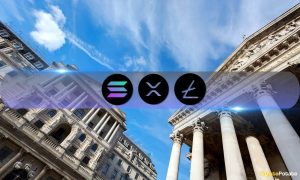
Crypto wallets, outflows, AuM, Bitcoin, Ethereum, and investments: analysts at CoinShares, the largest digital asset investment and trading group in Europe, analyzed and discussed digital asset inflows during 2022.
Indeed, CoinShares’ goal is to make innovative financial products and services that provide investors with confidence and transparency to build the future of investing.
A cryptocurrency wallet is a device/service that stores public and/or private keys for transactions made in crypto.
CoinShares’ report for 2022: capital inflows and increased use of crypto wallets
According to CoinShares, digital assets recorded inflows totaling $433 million for the full 2022, the lowest since 2018, when there were inflows of only $233 million.
In proportion, mid-year outflows in early 2018 were much more aggressive than they were in 2022, with total weekly outflows reaching 1.8% of total assets under management at one point.
By comparison, outflows in 2022 peaked weekly, representing only 0.7% of AuM. That aside, inflows were significantly lower than in 2021 and 2020, when there were inflows of $9.1 billion and $6.6 billion, respectively.
However, CoinShares notes that in a year when the price of Bitcoin has fallen 63%, in which there has been a clear bear market accelerated by irrational exuberance and an overly aggressive Fed, it is encouraging to see that investors, on the whole, still choose to invest.
Moreover, in many cases they tactically add some positions precisely during price weakness.
In addition, CoinShares notes that Bitcoin and other multi-asset investment products have been the main beneficiaries, with inflows totaling $287 million and $209 million, respectively.
However, Ethereum has had a tumultuous year, which analysts believe is due to investor concerns over a successful transition to the stake test and continued concerns over the timing of un-staking, which is expected to occur in the second quarter of 2023.
Finally, CoinShares confirms that 2022 saw the emergence of short-investment products that saw $108 million in inflows, although they remain a niche asset representing only 1.1% of Bitcoin’s total AuM.
AuM: Why is it important for investors in financial markets?
Asset Under Management (AUM) is an indicator that expresses the amount of assets under management held by an investment fund or asset management company (AMC) or other type of financial company.
However, when it comes to AuM it is difficult to provide a standard definition because asset management differs from state to state according to local regulations, but also because each financial management company that builds its portfolio, including crypto, uses different calculation models.
The management of the financial portfolio and its composition is generally handled by professionals, called asset managers, who select the asset classes to be included with the aim of achieving the highest possible return based on the level of risk chosen by the investor.
So, thanks to the AuM the investor understands the size of the financial company compared to the competition. Of course, in the overall assessment, this is only one of the indicators, since the fact that a financial company manages significant assets does not automatically translate into quality. The AuM indicator also does not offer details on investment potential.
The highest AuM globally: exchange traded funds (ETFs)
The funds that have the highest assets under management (AuM) on the global landscape are found in the United States. The US financial market in particular has the exchange traded funds with the highest assets under management.
Exchange-traded funds refer to those well-known as exchange traded funds (ETFs). These are investment funds whose job is to replicate the performance of a stock index such as the FTSE MIB or Dow Jones (DJI).
Chief among the ETF funds with the most substantial asset under management is the SPDR S&P 500 ETF Trust (SPY), which replicates the performance of the S&P 500 index benchmark of the top 500 US-listed companies: the ETF has a market capitalization of about $381.7 billion.
Next, there is the iShares Core S&P 500 ETF (IVV), also linked to the S&P 500 index, In this case, the market capitalization is about $290.5 billion. The Vanguard Total Stock Market ETF (VTI), on the other hand, is a exchange-traded fund that offers exposure to the US financial market in a very broad and varied form, as it invests funds under management in hundreds of different equities from multiple industries. Specifically, VTI totals an AuM of nearly $256 billion.
Next is another Vanguard ETF, also linked to the S&P 500 like the previous ones. The Vanguard S&P 500 ETF (VOO) totals a market capitalization of about $236.5 billion.
Finally, the Invesco QQQ Trust (QQQ), which with a market capitalization of about $179.2 billion, is the first under $200 billion. Its uniqueness lies in its daily trading volume, which is second only to the first ETF introduced, the SPY.





















